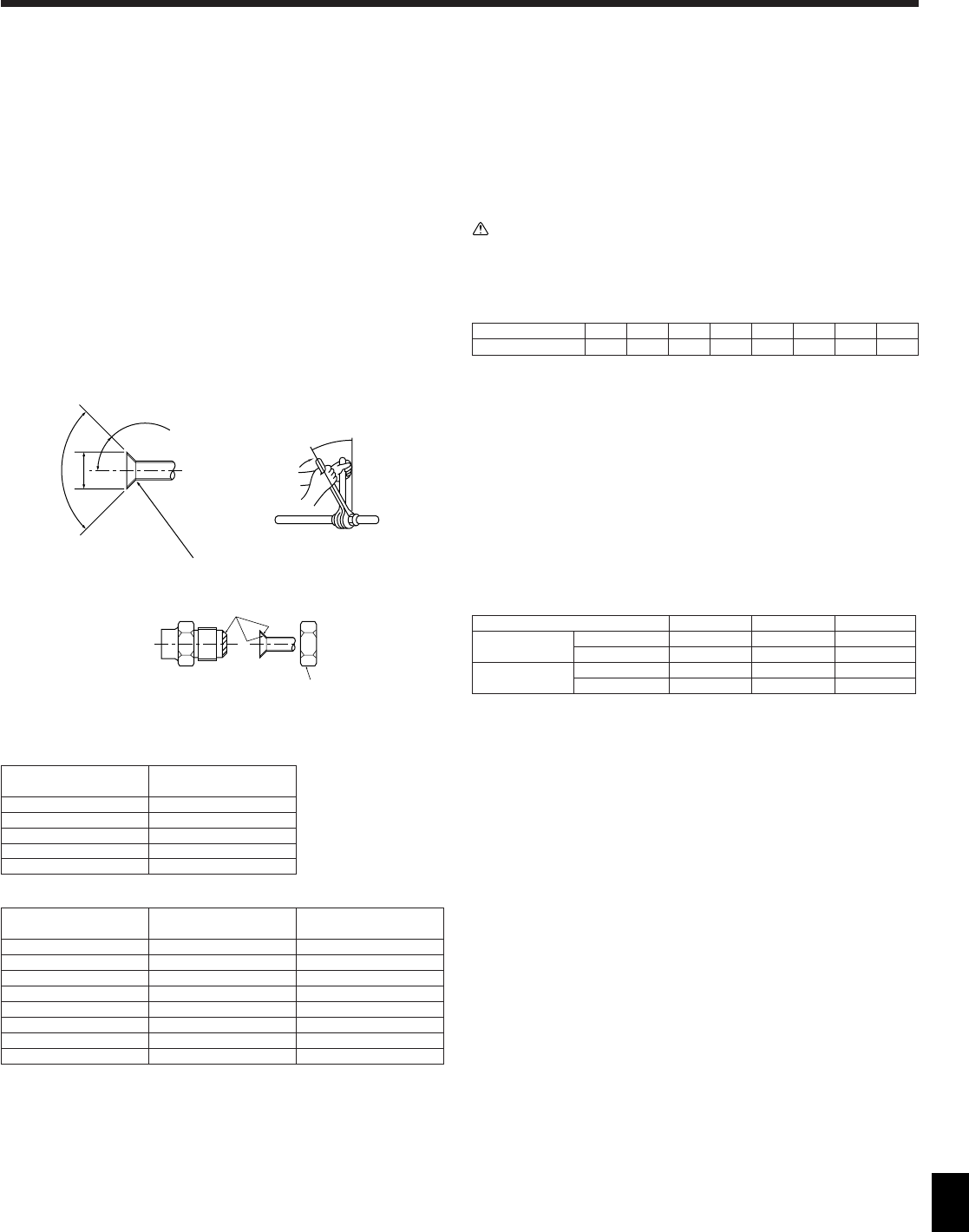
7
5. Installing the refrigerant piping
A Flare cutting dimensions
B Flare nut tightening torque
90° ±0.5°
øA
R0.4~R0.8
A
45°±2°
B
C
D
Fig. 5-1
5.1. Precautions for devices that use R410A refrigerant
• Refer to page 3 for precautions not included below on using air conditioners
with R410A refrigerant.
• Use ester oil, ether oil, alkylbenzene oil (small amount) as the refrigeration oil
applied to the flared sections.
• Use C1220 copper phosphorus, for copper and copper alloy seamless pipes,
to connect the refrigerant pipes. Use refrigerant pipes with the thicknesses
specified in the table to the below. Make sure the insides of the pipes are
clean and do not contain any harmful contaminants such as sulfuric com-
pounds, oxidants, debris, or dust.
• Always use a non-oxidizing brazing material when brazing the pipes. The com-
pressor will be damaged if this type of brazing material is not used.
Warning:
When installing or moving the air conditioner, use only the specified refriger-
ant (R410A) to charge the refrigerant lines. Do not mix it with any other refriger-
ant and do not allow air to remain in the lines. Air enclosed in the lines can
cause pressure peaks resulting in a rupture and other hazards.
Pipe size (mm) ø6.35 ø9.52 ø12.7 ø15.88 ø19.05 ø22.2 ø25.4 ø28.58
Thickness (mm) 0.8 0.8 0.8 1.0 1.0 1.0 1.0 1.0
• Do not use pipes thinner than those specified above.
5.2. Connecting pipes (Fig. 5-1)
• When commercially available copper pipes are used, wrap liquid and gas pipes
with commercially available insulation materials (heat-resistant to 100 °C or more,
thickness of 12 mm or more).
• The indoor parts of the drain pipe should be wrapped with polyethylene foam insu-
lation materials (specific gravity of 0.03, thickness of 9 mm or more).
• Apply thin layer of refrigerant oil to pipe and joint seating surface before tightening
flare nut. A
• Use two wrenches to tighten piping connections. B
• Use leak detector or soapy water to check for gas leaks after connections are com-
pleted.
• Apply refrigerating machine oil over the entire flare seat surface. C
* Do not apply to threaded portion. (It will cause the flare nut to loosen.)
• Use the flare nuts as follows. D
RP50 RP60, 71 RP100-140
Gas side Pipe size (mm) ø12.7 ø15.88 ø15.88
Indoor nut *2 *1 *2
Liquid side Pipe size (mm) ø6.35 ø9.52 ø9.52
Indoor nut *2 *1 *1
*1: The flare nut is attached to its pipe.
*2: The flare nut is in the multi distribution pipe accessory.
Do not use the flare nut attached. If it is used, a gas leakage or even a pipe
extraction may occur.
• When bending the pipes, be careful not to break them. Bend radii of 100 mm to 150
mm are sufficient.
• Make sure the pipes do not contact the compressor. Abnormal noise or vibration
may result.
(1)Pipes must be connected starting from the indoor unit.
Flare nuts must be tightened with a torque wrench.
(2)Flare the liquid pipes and gas pipes and apply a thin layer of refrigeration oil (Ap-
plied on site).
• When usual pipe sealing is used, refer to Table 1 for flaring of R410A refrigerant
pipes.
The size adjustment gauge can be used to confirm A measurements.
• Always use a non-oxidizing brazing material when brazing the pipes. Only use good-
quality brazing materials.
A (Fig. 5-1)
Copper pipe O.D. Flare dimensions
(mm) øA dimensions (mm)
ø6.35 8.7 - 9.1
ø9.52 12.8 - 13.2
ø12.7 16.2 - 16.6
ø15.88 19.3 - 19.7
ø19.05 23.6 - 24.0
Copper pipe O.D. Flare nut O.D. Tightening torque
(mm) (mm) (N·m)
ø6.35 17 14 - 18
ø6.35 22 34 - 42
ø9.52 22 34 - 42
ø12.7 26 49 - 61
ø12.7 29 68 - 82
ø15.88 29 68 - 82
ø15.88 36 100 - 120
ø19.05 36 100 - 120
B (Fig. 5-1)


















